26th August, 2025
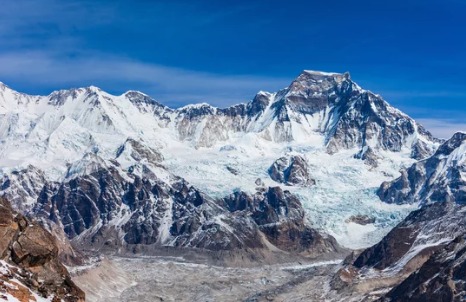
Jul 01, 2024
Lobuche Peak Climbing In July
- Introduction
- Overview of Lobuche Peak Climbing
- Weather and Climatic Conditions in July
- Preparing for Lobuche Peak Climbing
- Physical Fitness and Training
- Essential Gear and Equipment
- Permits and Regulations
- Getting to Lobuche Base Camp
- Climbing Route and Highlights
- Technical Challenges and Safety Tips
- Acclimatization and Altitude Considerations
- Accommodation and Facilities
- Cultural and Natural Highlights
- Summit Day Experience
- Side Trips and Optional Extensions
- Hiring a Guide or Climbing Solo
- Budgeting and Costs
- Responsible Climbing Practices
- Tips and Recommendations for Climbing Lobuche Peak
- Conclusion and Reflections
- Lobuche Peak Climbing Packages
Climbing Lobuche Peak in July offers a unique and exhilarating adventure amidst the towering peaks of the Everest region in Nepal. Lobuche Peak stands at an elevation of 6,119 meters (20,075 feet) and is renowned among trekkers and climbers for its challenging ascent and breathtaking views of the Himalayas.
July falls during the monsoon season in Nepal, which typically lasts from June to September. This period brings warm temperatures to the Everest region, with daytime temperatures ranging from 5°C to 15°C (41°F to 59°F) at higher altitudes. However, it also brings frequent rainfall, particularly in the afternoons and evenings, which can affect visibility and trail conditions.
Despite the monsoon rains, July offers certain advantages for climbing Lobuche Peak. The weather tends to be warmer compared to the colder winter months, making it more comfortable for climbers at higher altitudes. The trails and climbing routes are less crowded during this time, providing a quieter and more serene experience on the mountain.
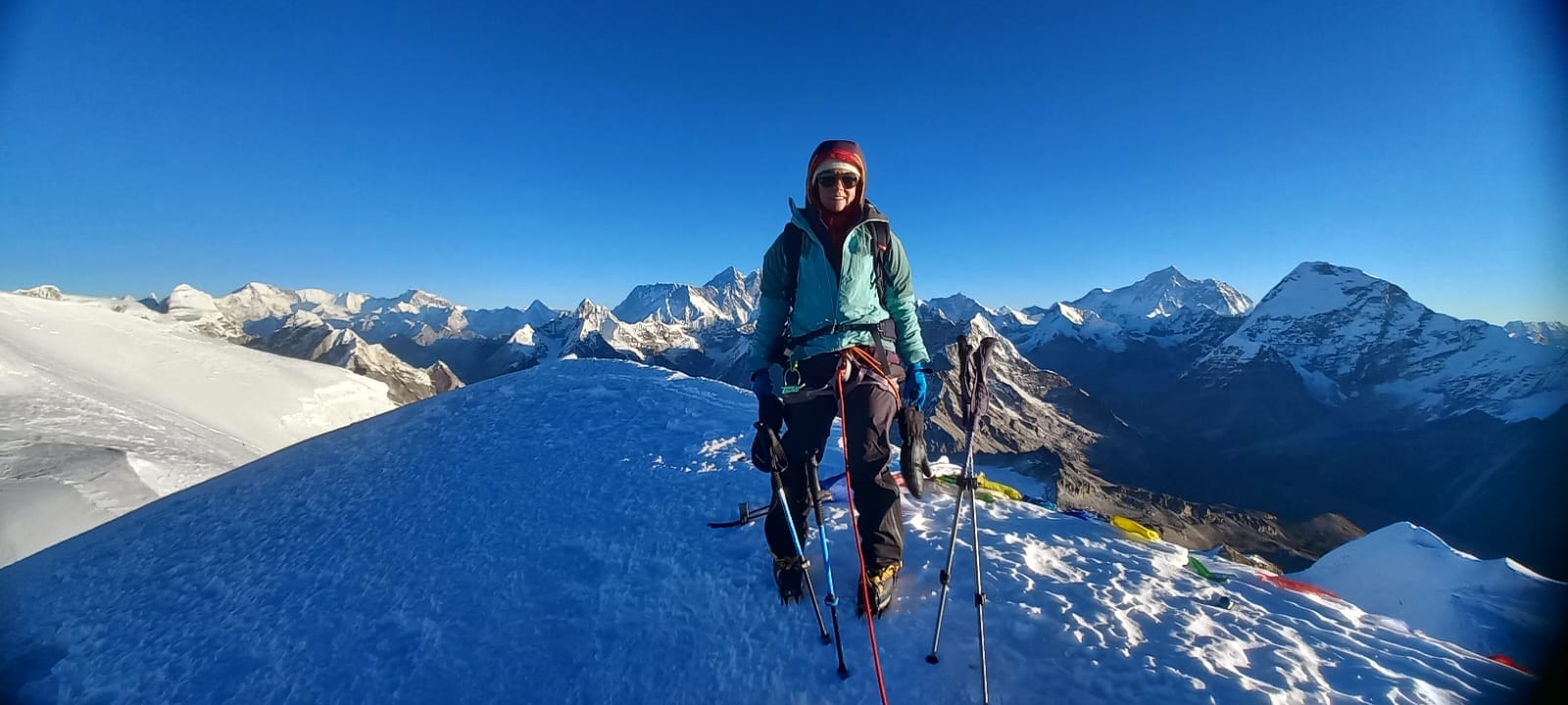
Three Peak Expedition
Embark on an unforgettable journey to the heart of the Himalayas as you conquer three majestic peaks: Mera Peak, Island Peak, and Lobuche Peak. This ultimate adventure combines technical climbing, bre...
One of the primary challenges of climbing Lobuche Peak in July is the weather. Monsoon rains can make trails slippery and increase the risk of rockfalls or avalanches, particularly in the higher elevations. Trekkers and climbers must be prepared for sudden changes in weather and carry adequate rain gear and waterproof clothing.
Altitude acclimatization is crucial when climbing Lobuche Peak, especially in July when the air is more humid and oxygen levels may feel lower due to the moisture in the air. It's essential to ascend gradually, allowing the body to adjust to the altitude and reduce the risk of altitude-related illnesses such as acute mountain sickness (AMS).
Climbers should undergo thorough physical training and preparation before attempting Lobuche Peak. This includes cardiovascular exercises, strength training, and hiking or climbing practice to build stamina and endurance. Acquiring proper climbing gear and equipment, including ropes, harnesses, crampons, ice axes, and helmets, is essential for safety on the mountain.
Choosing an experienced guide or joining a reputable climbing expedition team is highly recommended for navigating the challenging terrain and ensuring safety during the ascent. Guides provide valuable expertise on route planning, weather forecasts, and emergency protocols, enhancing the overall climbing experience.
Climbing Lobuche Peak in July offers a thrilling and rewarding experience for adventure enthusiasts seeking to explore the pristine beauty of the Everest region. While the monsoon season presents challenges with weather and trail conditions, careful planning, adequate preparation, and respect for safety protocols can lead to a successful ascent of this majestic peak, creating lasting memories of conquering the heights of the Himalayas.
Introduction
Climbing Lobuche Peak in July presents a thrilling opportunity for mountaineers to conquer one of Nepal's renowned peaks amidst the challenges and rewards of the monsoon season. Situated in the Everest region, Lobuche Peak stands at 6,119 meters (20,075 feet) and offers panoramic views of the Himalayas, making it a coveted destination for adventure seekers.
Overview of Lobuche Peak Climbing
Lobuche Peak is a popular choice for climbers due to its technical challenges and stunning surroundings. It consists of two main summits: Lobuche East (6,119 meters) and Lobuche West (6,145 meters). The climbing route typically starts from Lobuche Base Camp, ascending through rocky terrain and glacier slopes before reaching the summit ridge. The ascent requires technical climbing skills, including navigating crevasses and fixed ropes, under the guidance of experienced mountaineers.
Weather and Climatic Conditions in July
July marks the monsoon season in Nepal, characterized by warmer temperatures and frequent rainfall. In the Everest region, daytime temperatures at higher altitudes range from 5°C to 15°C (41°F to 59°F), while nighttime temperatures can drop below freezing. The monsoon brings heavy rain showers, especially in the afternoon and evening, which can affect trail conditions, visibility, and safety during the climb.
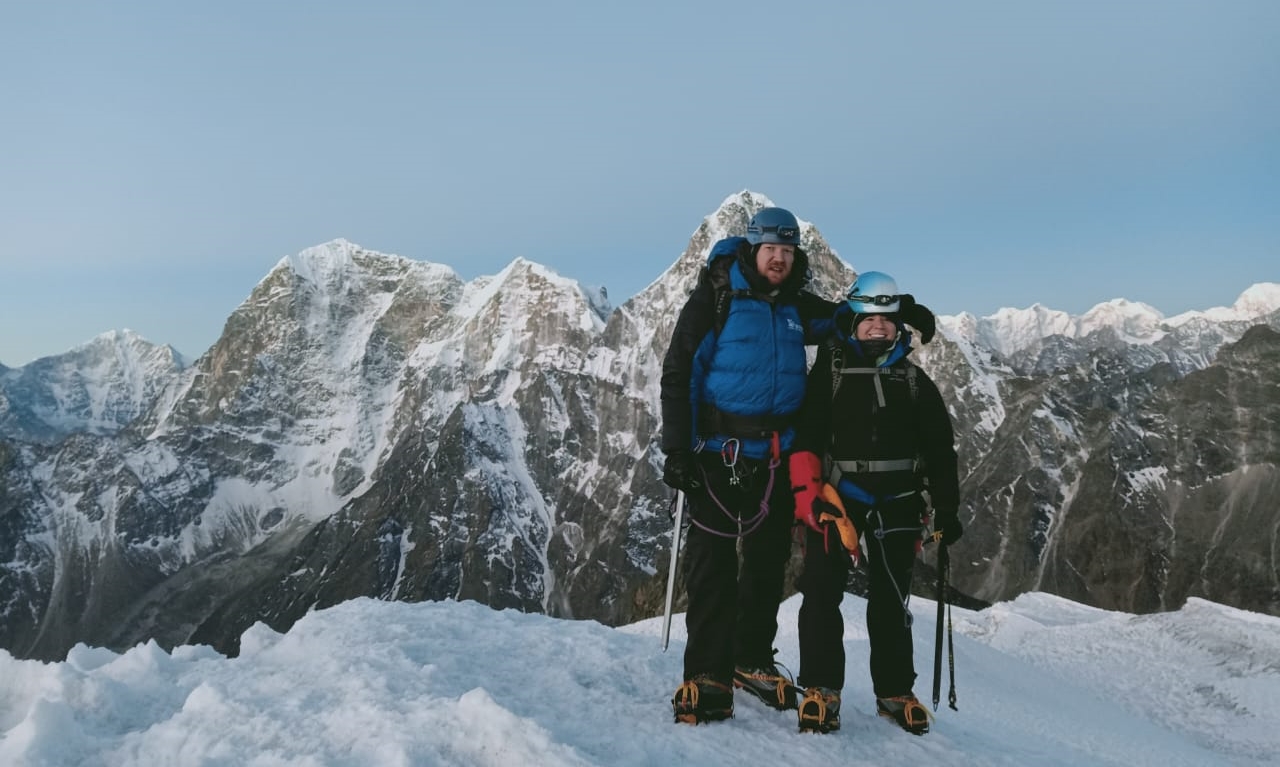
LOBUCHE PEAK CLIMBING
Lobuche East (6,119m/20,075ft), set in Nepal's stunning Khumbu on the Nepalese side of Everest.The best time to go trekking in Nepal is in Autumn (September-November) and in...
Preparing for Lobuche Peak Climbing
Successful preparation for Lobuche Peak climbing in July requires careful planning and consideration of various factors:
- Permits and Logistics: Obtain necessary permits from the Nepal Mountaineering Association (NMA) and arrange logistics such as accommodations and transportation to and from the trailhead.
- Climbing Gear: Equip yourself with essential climbing gear including crampons, ice axes, harnesses, helmets, and appropriate clothing layers for varying weather conditions. Ensure all equipment is in good condition and suitable for high-altitude climbing.
- Acclimatization: Plan for adequate acclimatization days during the ascent to mitigate the effects of altitude sickness. Gradual ascent and rest days at intermediate camps, such as Lobuche Base Camp and High Camp, are crucial for adjusting to higher elevations.
Physical Fitness and Training
Physical fitness is paramount for climbing Lobuche Peak, particularly in challenging conditions like those encountered during the monsoon season:
- Cardiovascular Endurance: Build cardiovascular fitness through activities like running, cycling, and hiking to enhance stamina for sustained climbing efforts at high altitude.
- Strength Training: Strengthen muscles, particularly in the legs, core, and upper body, to handle the demands of carrying heavy gear and navigating rugged terrain.
- Altitude Simulation: If possible, simulate high-altitude conditions through altitude training or climbing other peaks to familiarize yourself with reduced oxygen levels and acclimate more effectively.
Preparing mentally is equally important. Stay informed about current weather forecasts and trail conditions, maintain flexibility in your itinerary to adapt to changing circumstances, and prioritize safety at all times during the climb.
Climbing Lobuche Peak in July offers a challenging yet rewarding adventure amid Nepal's stunning Himalayan landscape. With thorough preparation, physical readiness, and respect for the mountain environment, climbers can embark on a memorable journey to conquer the heights of Lobuche Peak and witness the breathtaking vistas it offers.

LOBUCHE PEAK SUMMIT RETURN BY HELICOPTER
A real climbing adventure that will leave you stunned at the beauty of the Himalayan Mountains. The Lobuche Peak Climbing expedition in the spectacular Khumbu region of Nepal has been ranked by Lonely...
Essential Gear and Equipment
Climbing Lobuche Peak requires a comprehensive set of gear and equipment to ensure safety and comfort during the ascent:
- Climbing Gear: Harness, helmet, crampons, ice axe, ropes, carabiners, and ascenders.
- Clothing: Insulated jacket, waterproof shell layers, thermal base layers, gloves, and mountaineering boots.
- Camping Gear: Tent, sleeping bag rated for sub-zero temperatures, sleeping pad, and cooking equipment.
- Navigation and Communication: GPS device, map, compass, and satellite phone.
- Personal Items: Sunglasses, sunscreen, lip balm, headlamp, and first aid kit.
Permits and Regulations
Before attempting Lobuche Peak, climbers must obtain necessary permits from the Nepal Mountaineering Association (NMA). This includes a climbing permit specific to Lobuche Peak and the required TIMS (Trekkers' Information Management System) card. It's essential to carry these permits at all times during the climb and comply with local regulations to ensure a smooth and legal ascent.
Getting to Lobuche Base Camp
The journey to Lobuche Base Camp typically begins with a flight from Kathmandu to Lukla, followed by a trek through the picturesque villages and rugged terrain of the Everest region. From Lukla, trekkers proceed through Namche Bazaar, Dingboche, and ultimately arrive at Lobuche Base Camp. The trek offers stunning views of Himalayan landscapes and provides ample opportunities for acclimatization along the way.

MERA PEAK CLIMBING 17 DAYS
This is an excellent opportunity to climb Nepal’s highest peak without having to obtain a permit (6,476m/21,190ft). From the summit, you will have stunning views of several 8000m plus peaks, such as E...
Climbing Route and Highlights
The climbing route to Lobuche Peak generally starts from Lobuche Base Camp, where climbers prepare for the ascent. The route involves crossing glacial terrain, navigating crevasses, and ascending steep slopes with fixed ropes. Highlights include panoramic views of Everest, Lhotse, Nuptse, and other prominent peaks of the Everest region. Climbers often make a summit attempt from Lobuche High Camp, which requires technical skill and endurance.
Technical Challenges and Safety Tips
Climbing Lobuche Peak presents several technical challenges and requires adherence to safety protocols:
- Altitude: Acclimatization is critical to prevent altitude sickness. Plan rest days and ascend gradually to allow the body to adjust to higher elevations.
- Weather: Monitor weather forecasts closely. July can bring monsoon rains and storms, affecting visibility and trail conditions. Be prepared for sudden weather changes and prioritize safety.
- Technical Skills: Climbers should be proficient in basic mountaineering techniques such as rope handling, glacier travel, and ice climbing. Follow the guidance of experienced guides and prioritize teamwork.
- Emergency Preparedness: Carry a comprehensive first aid kit, communication devices, and emergency shelter. Familiarize yourself with evacuation procedures in case of emergencies.
By equipping yourself with the right gear, obtaining necessary permits, understanding the climbing route, and preparing for technical challenges and safety considerations, you can embark on a successful and rewarding ascent of Lobuche Peak. Respect for the environment and local regulations ensures a responsible and memorable climbing experience in the majestic Himalayas.

ISLAND PEAK CLIMBING
Sherpa Expedition & Trekking (Est.1977) are pleased to announce FOR ADVENTURERS the most awesome, exhilarating & unforgettable climbing and treks on offer anywhere today!...
Acclimatization and Altitude Considerations
Acclimatization is crucial when climbing Lobuche Peak, especially due to its high altitude of 6,119 meters (20,075 feet). Adequate acclimatization helps prevent altitude sickness and ensures a safer ascent. Climbers typically spend several days trekking to gradually acclimatize to higher altitudes. Common acclimatization stops include Dingboche and Lobuche Base Camp, where climbers rest and allow their bodies to adjust to reduced oxygen levels. It's essential to hydrate well, maintain a steady pace, and listen to your body's signals to avoid altitude-related illnesses.
Accommodation and Facilities
Accommodation options along the Lobuche Peak trek route primarily consist of teahouses and basic lodges. These establishments offer simple yet comfortable lodging with amenities such as beds, blankets, and communal dining areas. Lodging conditions become more basic as climbers ascend higher, with limited electricity and shared bathroom facilities. It's advisable to carry a sleeping bag suitable for cold temperatures and be prepared for rustic accommodations at higher altitudes.
Cultural and Natural Highlights
The journey to Lobuche Peak traverses through the culturally rich and naturally diverse landscapes of the Everest region. Cultural highlights include visits to Sherpa villages like Namche Bazaar and Tengboche, where climbers can explore Buddhist monasteries adorned with prayer flags and intricate architecture. Natural highlights encompass breathtaking views of Himalayan peaks, serene alpine lakes, and lush rhododendron forests during the trek. These cultural and natural elements offer a profound immersion into the unique Himalayan environment and the Sherpa culture.

CHULU FAR EAST PEAK CLIMBING
Are you looking for adventure, natural beauty, magnificent snow-capped peaks, and unique cultural experience?This Peak Climbing will give you all the thrills, variety, and the adrenalin rush as you cl...
Summit Day Experience
Summit day on Lobuche Peak is a culmination of weeks of preparation and climbing efforts. Climbers typically begin early in the morning, navigating through challenging terrain and steep ascents. The final push to the summit involves using fixed ropes and negotiating technical sections like crevasses and ice walls. Upon reaching the summit, climbers are rewarded with awe-inspiring panoramic views of Everest, Lhotse, Nuptse, and other Himalayan giants. It's a moment of triumph and celebration, marking the successful accomplishment of the climbing expedition.
Side Trips and Optional Extensions
For adventurers seeking additional challenges and exploration, the Lobuche Peak trek offers opportunities for side trips and optional extensions. Popular side trips include visits to Everest Base Camp and Kala Patthar, renowned for their spectacular views of Mount Everest. Extension options may include treks to Gokyo Lakes or Island Peak, providing diverse landscapes and further adventure in the Everest region. These side trips and extensions enrich the climbing experience, offering more opportunities to discover the natural beauty and cultural heritage of the Himalayas beyond Lobuche Peak.
Hiring a Guide or Climbing Solo
Deciding whether to hire a guide or climb Lobuche Peak solo depends on your experience, skills, and comfort level in high-altitude and technical mountain terrain. Hiring a guide is advisable for less experienced climbers or those unfamiliar with the region. Guides provide invaluable knowledge of the route, ensure safety protocols are followed, and offer assistance in navigating challenging sections. They also facilitate communication with local communities and help arrange logistics such as permits and accommodations. Climbing solo requires a high degree of self-reliance, proficiency in mountaineering skills, and thorough preparation in route planning, navigation, and emergency response.
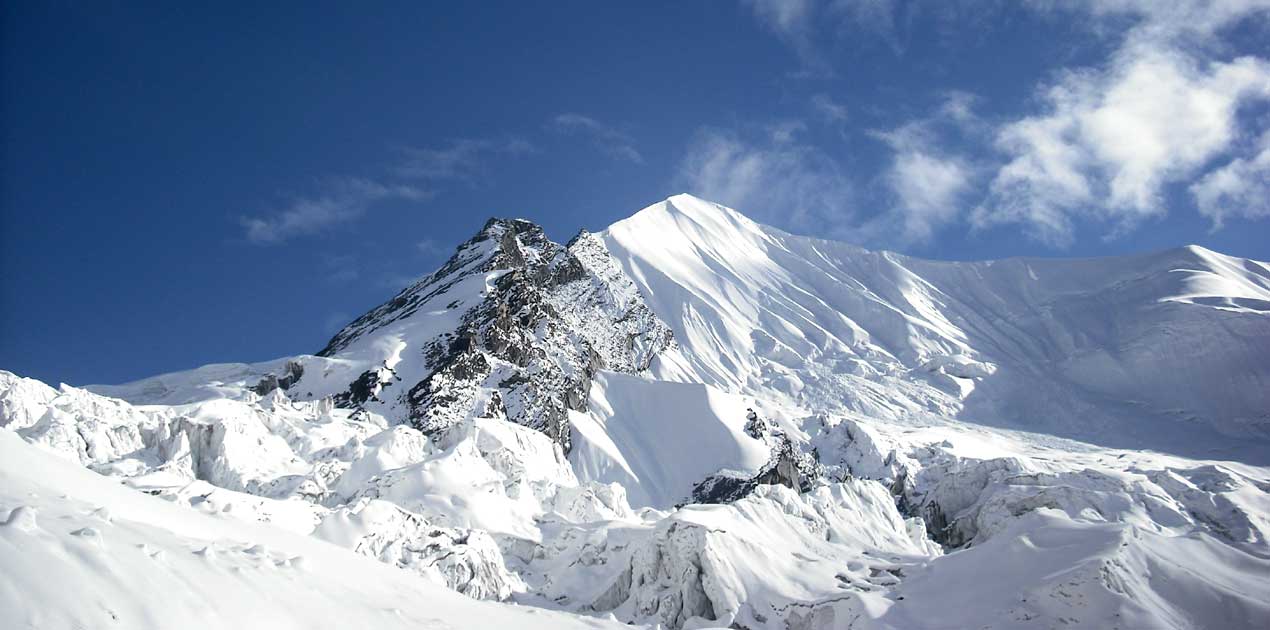
PACHERMO PEAK CLIMBING
Believe in yourself! You have what it takes to summit this beautiful peak in the remote Rolwaling district in the northeast of Nepal – near the Tibetan border. It is physically demanding, but with som...
Budgeting and Costs
Budgeting for climbing Lobuche Peak includes various expenses such as permits, guide fees (if applicable), accommodations, meals, transportation to and from the trekking route, gear rental or purchase, and additional personal expenses. Costs can vary widely depending on whether you hire a guide, the duration of your trek, and the quality of accommodations chosen. It's essential to budget for unforeseen expenses and factor in costs for travel insurance, which is crucial for covering emergency medical evacuation in the event of altitude sickness or injury.
Responsible Climbing Practices
Responsible climbing practices are essential to minimize environmental impact and respect local culture during your ascent of Lobuche Peak. This includes adhering to Leave No Trace principles by disposing of waste properly and carrying out all trash, including biodegradables. Respect local customs and traditions, particularly around sacred sites and cultural monuments. Contribute to sustainable tourism practices by supporting local businesses, minimizing resource consumption, and promoting conservation efforts in the Everest region.
Tips and Recommendations for Climbing Lobuche Peak
- Physical Fitness: Prepare with cardiovascular and strength training, focusing on endurance and muscle stamina.
- Acclimatization: Plan gradual ascents with rest days to acclimate to high altitudes.
- Gear Preparation: Ensure all climbing gear is in good condition and suitable for high-altitude conditions.
- Weather Monitoring: Stay informed about weather forecasts and be prepared for sudden changes in weather conditions.
- Hydration and Nutrition: Maintain hydration levels and consume a balanced diet to sustain energy levels during the climb.
- Emergency Preparedness: Carry a comprehensive first aid kit, communication devices, and emergency shelter in case of unexpected situations.
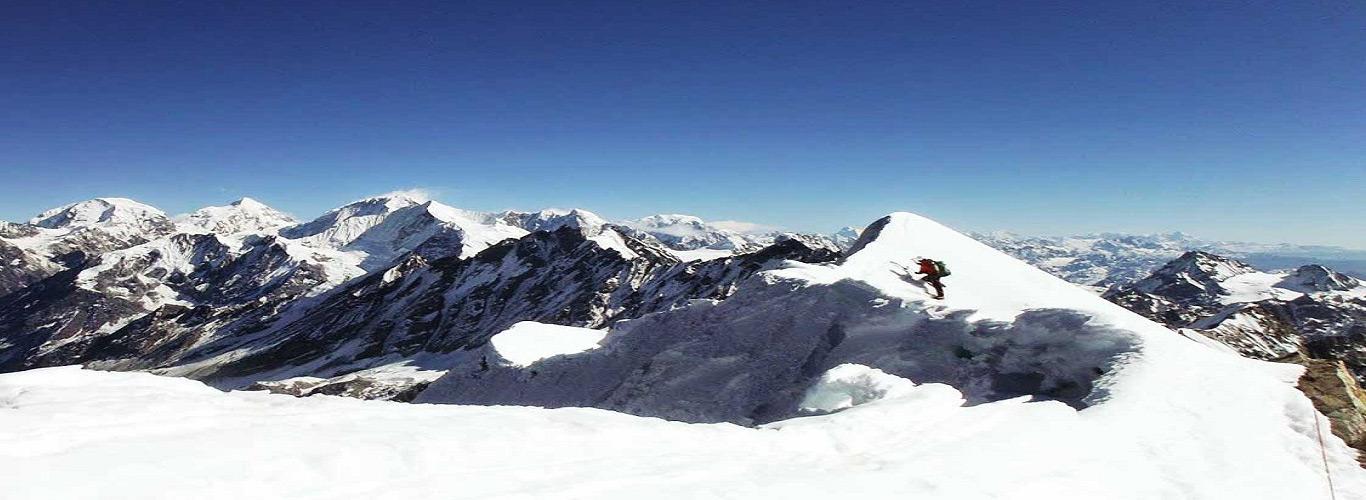
NAYA KHANG PEAK CLIMBING
Mountains, monasteries, and high passes are just a taste of what you will encounter on this amazing adventure in the Langtang district of Nepal that takes you to the summit of Naya Khang Peak (5846m)...
Conclusion and Reflections
Climbing Lobuche Peak is not just a physical challenge but also a journey of personal growth and cultural exploration. The experience offers unparalleled views of the Himalayas and a deep connection with the natural environment. Reflect on the challenges overcome, the lessons learned, and the friendships forged along the way. Whether you summit as part of a guided expedition or venture solo, the memories and achievements from climbing Lobuche Peak will endure as a testament to your adventurous spirit and determination in the heart of the Himalayas.
Lobuche Peak Climbing Packages
Lobuche Peak Summit Return By Helicopter
Lobuche Peak Expedition 14 Days
Lobuche Peak Expedition 15 Days

PISANG PEAK CLIMBING
Do you have the urge to go higher and test your endurance? Take a 6091m detour off the beaten track to a pyramid-shaped peak north of Pisang and Annapurna II on the Annapurna Circuit trail. ...
Any Questions? Let Us Know.
Recent Posts
17th June, 2025


















